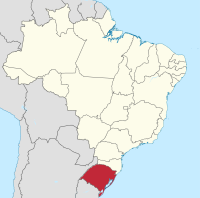
Photo from wikipedia
Background Reports of a lack of efficacy of most of the anthelmintic compounds for ruminants associated with the long-time necessity for creating new molecules have stressed the urgency to adopt… Click to show full abstract
Background Reports of a lack of efficacy of most of the anthelmintic compounds for ruminants associated with the long-time necessity for creating new molecules have stressed the urgency to adopt alternative methods to control gastrointestinal parasites infection, such as strategies of sharing grazing areas. Therefore, this study aimed to evaluate nematode populations affecting cattle and sheep that share grazing areas before and after treatment with different anthelmintic compounds, and investigate the efficacy of anthelmintic treatment in these naturally infected ruminants at farms in the state of Rio Grande do Sul, Brazil. Methods The presence of co-infections by Haemonchus species was investigated by polymerase chain reaction (PCR) for groups treated with a benzimidazole. Farms were selected by: farmers’ consent, presence of 42–60 (or more) calves and sheep per farm with counts of ≥ 200 eggs per gram of feces (EPG), availability of calves and lambs aging from 6 to 9 months, absence of anthelmintic treatment for both species for 60 days before the experimental period, and shared grazing areas between this species on each farm. Animals were distributed into six treatment groups for each ruminant species per farm and treated with: ivermectin, doramectin, moxidectin, levamisole, albendazole, and closantel. Results Levamisol was the most effective anthelmintic compound for both ruminant species. In general, Cooperia spp., Haemonchus spp., and Trichostrongylus spp. were the genus present after tested treatments that were ineffective. PCR showed the presence of Haemonchus species co-infections between cattle and sheep. Conclusion Therefore, this study demonstrated the similarity between nematode population, the presence of multi-resistant nematodes, and the presence of Haemonchus species co-infections affecting different ruminant species that share pastures.
Journal Title: Acta Parasitologica
Year Published: 2019
Link to full text (if available)
Share on Social Media: Sign Up to like & get
recommendations!